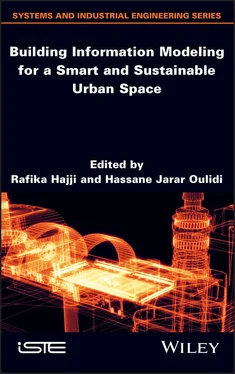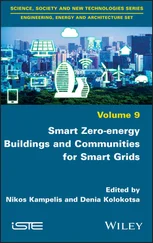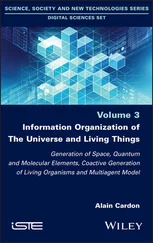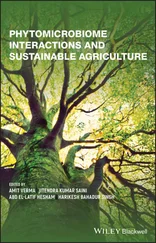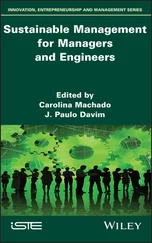Building Information Modeling for a Smart and Sustainable Urban Space
Здесь есть возможность читать онлайн «Building Information Modeling for a Smart and Sustainable Urban Space» — ознакомительный отрывок электронной книги совершенно бесплатно, а после прочтения отрывка купить полную версию. В некоторых случаях можно слушать аудио, скачать через торрент в формате fb2 и присутствует краткое содержание. Жанр: unrecognised, на английском языке. Описание произведения, (предисловие) а так же отзывы посетителей доступны на портале библиотеки ЛибКат.
- Название:Building Information Modeling for a Smart and Sustainable Urban Space
- Автор:
- Жанр:
- Год:неизвестен
- ISBN:нет данных
- Рейтинг книги:3 / 5. Голосов: 1
-
Избранное:Добавить в избранное
- Отзывы:
-
Ваша оценка:
- 60
- 1
- 2
- 3
- 4
- 5
Building Information Modeling for a Smart and Sustainable Urban Space: краткое содержание, описание и аннотация
Предлагаем к чтению аннотацию, описание, краткое содержание или предисловие (зависит от того, что написал сам автор книги «Building Information Modeling for a Smart and Sustainable Urban Space»). Если вы не нашли необходимую информацию о книге — напишите в комментариях, мы постараемся отыскать её.
Building Information Modeling for a Smart and Sustainable Urban Space — читать онлайн ознакомительный отрывок
Ниже представлен текст книги, разбитый по страницам. Система сохранения места последней прочитанной страницы, позволяет с удобством читать онлайн бесплатно книгу «Building Information Modeling for a Smart and Sustainable Urban Space», без необходимости каждый раз заново искать на чём Вы остановились. Поставьте закладку, и сможете в любой момент перейти на страницу, на которой закончили чтение.
Интервал:
Закладка:
101 83
102 84
103 85
104 86
105 87
106 88
107 89
108 90
109 91
110 92
111 93
112 95
113 96
114 97
115 98
116 99
117 100
118 101
119 102
120 103
121 104
122 105
123 106
124 107
125 108
126 109
127 110
128 111
129 112
130 113
131 114
132 115
133 116
134 117
135 118
136 119
137 120
138 121
139 122
140 123
141 124
142 125
143 126
144 127
145 128
146 129
147 130
148 131
149 132
150 133
151 134
152 135
153 136
154 137
155 138
156 139
157 141
158 142
159 143
160 145
161 147
162 148
163 149
164 150
165 151
166 152
167 153
168 154
169 155
170 156
171 157
172 158
173 159
174 160
175 161
176 162
Building Information Modeling for a Smart and Sustainable Urban Space
Edited by
Rafika Hajji
Hassane Jarar Oulidi

First published 2021 in Great Britain and the United States by ISTE Ltd and John Wiley & Sons, Inc.
Apart from any fair dealing for the purposes of research or private study, or criticism or review, as permitted under the Copyright, Designs and Patents Act 1988, this publication may only be reproduced, stored or transmitted, in any form or by any means, with the prior permission in writing of the publishers, or in the case of reprographic reproduction in accordance with the terms and licenses issued by the CLA. Enquiries concerning reproduction outside these terms should be sent to the publishers at the undermentioned address:
ISTE Ltd
27-37 St George’s Road
London SW19 4EU
UK
www.iste.co.uk
John Wiley & Sons, Inc.
111 River Street
Hoboken, NJ 07030
USA
www.wiley.com
© ISTE Ltd 2021
The rights of Rafika Hajji and Hassane Jarar Oulidi to be identified as the authors of this work have been asserted by them in accordance with the Copyright, Designs and Patents Act 1988.
Library of Congress Control Number: 2021945741
British Library Cataloguing-in-Publication Data
A CIP record for this book is available from the British Library
ISBN 978-1-78630-703-3
Preface
Multi-scale Building Information Modeling (BIM) has the potential to become a powerful decision support tool for urban planning. It can be used to facilitate many applications in various fields such as wind simulations, energy studies, noise studies and various types of analyses that require placing a planned architectural design in its context and being able to follow its implementation and evolution in an urban context, and connecting it with other urban components such as networks, road infrastructures, etc. The 3D urban model has become an essential support for better communication with all stakeholders on urban issues.
This book presents the theoretical and practical basis for implementing a multi-scale BIM. It addresses the issues of data acquisition, modeling, integration and information sharing in an interoperable framework. The book analyzes and provides the basics of BIM and Geographic Information System (GIS) integration in the context of urban management, a preliminary step to achieve the intelligent and sustainable management of an urban space. This book also presents practical case studies illustrating some aspects of using the concept of multi-scale BIM to address certain urban issues, including the segmentation of Light Detection and Ranging (LiDAR) data for BIM modeling, the integration of BIM and 3D GIS for property value simulations and the contribution of BIM and 3D GIS to urban renewal.
Rafika HAJJI
Hassane JARAR OULIDI
September 2021
Acknowledgments
I would like to thank all the people who influenced my professional journey and contributed to the evolution of my career, in particular the direction and professors of IAV Hassan II.
My most sincere thanks go to Professor Hassane Jarar Oulidi with whom I collaborated in the writing of this book. My thanks also go to all the doctoral students who have devoted their time and efforts to advance our research questions, especially Ms. Siham El Yamani, Ms. Oumaima Moufid and Mr. Zouhair Ballouch, who have contributed to the writing of this book.
I would also like to thank the ISTE Ltd team for their high-quality professional work.
I will be sure to thank my mother and father for their unwavering support, trust and guidance.
I dedicate this work especially to my husband for his support and encouragement. I thank him for the sacrifices he has made for me. Thank you for the joy and happiness you bring to my life.
Rafika HAJJI
September 2021
I would like to thank the staff and professors at the Hassania School of Public Works (EHTP), in particular the Department of Mathematics, Computer Science and Geomatics.
Special thanks go to my wife Amina for her unfailing support and encouragement.
Hassane JARAR OULIDI
September 2021
List of Acronyms
| ADE | Application Domain Extension |
| AEC | Architecture/Engineering/Construction |
| AIA | American Institute of Architects |
| AR | Augmented Reality |
| B-Rep | Boundary Representation |
| BDS | Building Description System |
| BIM | Building Information Modeling |
| BMLS | Backpack-Mounted Laser Scanners |
| bSI | buildingSMART International |
| CAD | Computer-Aided Design |
| CIM | City Information Modeling |
| CNN | Convolutional Neuron Network |
| CPM | Critical Path Method |
| CSG | Constructive Solid Geometry |
| DARCES | Data-Aligned Rigidity-Constrained Exhaustive Search |
| DBMS | DataBase Management System |
| DEM | Digital Elevation Model |
| DL | Deep Learning |
| DM | Dense Matching |
| DSM | Digital Surface Model |
| DTM | Digital Terrain Model |
| ETL | Extract, Transform, Load |
| FME | Feature Management Engine |
| FoV | Field of View |
| GIS | Geographic Information System |
| GLIDE | Graphical Language for Interactive DEsign |
| GLoD | Geometric Level of Detail |
| GNSS | Global Navigation Satellite System |
| GPS | Global Positioning System |
| HBIM | Historic Building Information Modeling |
| HMLS | Hand-held Mobile Laser Scanner |
| IAI | International Alliance for Interoperability |
| ICP | Iterative Closest Point |
| IDBE | Integrated Digital Built Environment |
| IDM | Information Delivery Manual |
| IFC | Industry Foundation Classes |
| IFD | Information Framework for Dictionaries |
| IMU | Inertial Measurement Unit |
| ISO | International Organization for Standardization |
| ISPRS | International Society for Photogrammetry and Remote |
| Sensing | |
| KML | Keyhole Markup Language |
| LiDAR | Light Detection And Ranging |
| LoA | Level of Accuracy |
| LoB | Line of Balance |
| LoD | “Level of Detail”/“Level of Development” |
| LoGeoRef | Level of GeoReferencing |
| LoI | Level of Information |
| ML | Machine Learning |
| MMS | Mobile Mapping System |
| MNO | Modifiable Nested Octree |
| MVD | Model View Definition |
| MVS | Multiple View Stereovision |
| NIBS | National Institute of Building Science |
| NURBS | Non-Uniform Rational Basic Spline |
| OGC | Open Geospatial Consortium |
| RANSAC | RANdom SAmple Consensus |
| RDF | Resource Description Framework |
| RGB-D | Red–Green–Blue-Depth |
| SFM | Structure From Motion |
| SIFT | Scale-Invariant Feature Transform |
| SIRS | Spatially Referenced Information Systems |
| SLAM | Simultaneous Localization And Mapping |
| SLoD | Semantic Level of Detail |
| SPR | Spatial Partitioning Representation |
| SURF | Speeded-Up Robust Features |
| UBM | Unified Building Model |
| VLL | Vertical Locus Line |
| xBIM | eXtensible Building Information Modeling |
Introduction
Интервал:
Закладка:
Похожие книги на «Building Information Modeling for a Smart and Sustainable Urban Space»
Представляем Вашему вниманию похожие книги на «Building Information Modeling for a Smart and Sustainable Urban Space» списком для выбора. Мы отобрали схожую по названию и смыслу литературу в надежде предоставить читателям больше вариантов отыскать новые, интересные, ещё непрочитанные произведения.
Обсуждение, отзывы о книге «Building Information Modeling for a Smart and Sustainable Urban Space» и просто собственные мнения читателей. Оставьте ваши комментарии, напишите, что Вы думаете о произведении, его смысле или главных героях. Укажите что конкретно понравилось, а что нет, и почему Вы так считаете.
